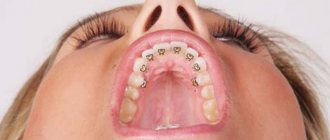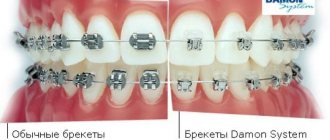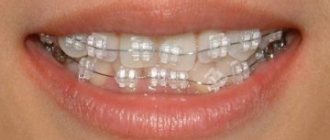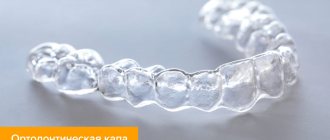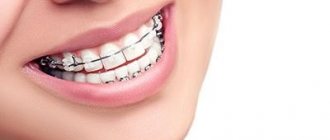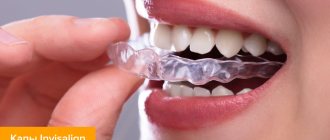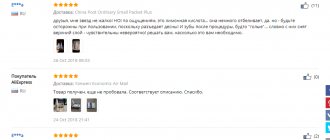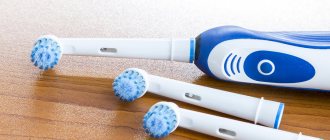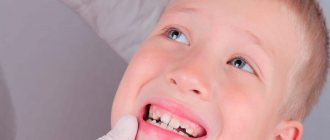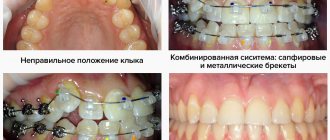A beautiful smile has three main components - health, whiteness and evenness of teeth. This is well known to everyone, but alas, not every person is given these components of a beautiful, attractive smile by nature.
80% of people in the world have some kind of malocclusion, which leads to the fact that the teeth grow unevenly, may have an unattractive shape, or there will be large and unaesthetic gaps between the teeth in the rows. But the situation with an unsightly shape or incorrect arrangement of teeth in a row is not irreparable - it can be corrected by orthodontic treatment, which involves the correction of malocclusion with special structures - braces.
To undergo orthodontic treatment, you need to go to a dental clinic, where an orthodontist will assess the degree of development of the bite defect and select the appropriate option for braces, which come in different types and differ in both the design device, the material of manufacture, and the area of installation.
Adult patients who want to undergo orthodontic treatment with braces and make it invisible to others can opt for lingual braces, the main feature of which is that they are placed not on the outer surfaces of the teeth, but on the inner ones. We have collected all the useful details on lingual braces and their installation for you in this article on our website.
Calculate the cost of treatment by taking a short test in 20 seconds!
Do not delay your treatment, because in this matter time plays against us.
The principle of operation of braces
A brace system is a mechanical device designed to move one or more teeth in a given direction. Translated from English, bracket is a bracket. It is the bracket-like element that represents one of the basic parts of the bracket system.
Structurally, the correction device consists of the following parts:
- plates (braces) attached with special glue to the inner or outer side of the dentition;
- power arch, fixed using fasteners on bracket plates.
The orthodontic clasp is given a configuration determined by the characteristics of a particular clinical situation. It is then inserted into the slots of the braces. The arch has “shape memory”, so it tends to return to its initial position, thereby creating pressure on the dental elements.
The principle of operation of correction devices is simple, like all ingenious things: braces fixed to the tooth enamel transfer to them the pressure force of the orthodontic clasp. This process is continuous, so dental units begin to shift along a given vector over time. The intensity of pressure on each unit is calculated by the orthodontist using a computer program. If it is required that the element moves in the longitudinal direction, then the bracket is fixed to its middle. If the tooth needs to be rotated, then the plate is attached closer to its edge. Each of the mini-locks has its own angle of inclination, depending on the pattern of the required movement.
The ability of teeth to move is explained by the peculiarity of their attachment in the alveolar sockets. Dental units below the coronal part are covered with periodontal tissue, which is fibrous connective tissue. It is she who holds the tooth roots in the alveoli. The basis of the periodontium is the periodontal ligaments; they connect the cement of the dental element with the alveolar matrix. Periodontal ligaments are not static; they contract and stretch to form osteoblasts (young bone cells) and osteoclasts (bone-removing cells). The power wire, through braces, presses on the tooth, causing these ligaments to stretch in one direction and compress in the other.
Types of bracket system designs
The classification of bracket structures depends on the selected classification feature:
- material of manufacture;
- fastening method;
- positioning.
Next, let's look at species differentiation in a little more detail.
Depending on the material from which the plates are made, bracket systems are:
- metal ones are reliable, but are significantly inferior to other mechanisms in aesthetic terms. As a rule, they are made of medical steel, sometimes with gold plating. Another option is titanium correction products. Titanium is a bioinert alloy, therefore it is recommended for people who are allergic to other metals;
- ceramic - the color of the plates practically matches the shade of the enamel, so they are practically invisible in the oral cavity;
- plastic - have good aesthetics, but wear out very quickly and become stained under the influence of food and smoking;
- sapphire – transparent, invisible, superior in strength to ceramic devices;
- combined - different materials are used in different areas of the mechanism. For example, in the smile zone there are sapphires, in the chewing zone there is metal.
Orthodontic equipment differs in the method of attachment. The classification is as follows:
- ligature – in these products the driving arch is attached to bracket plates using ligatures. These are special fastening parts - elastic rings or metal wires;
- non-ligature - here the guide clasp is secured by means of movable clamps (clips, latches, latches).
Correction systems differ from each other in their positioning location:
- vestibular - attached to the outside of the dental line. They are the traditional and most common type of orthodontic equipment.
- lingual - fixed on the inside of the teeth from the side of the tongue. Hence the name, “lingua” (lingua) translated from Latin means “language”.
The type of braces for the course of treatment is selected by the orthodontist at our clinic depending on the characteristics of each specific clinical case.
Possible complications
Lingual braces require careful selection of the model and its correct installation. With this approach, there are practically no complications. But the dentist must take into account the possibility of their occurrence. Complications include:
- irritation of the tongue by metal parts of the system; the addition of an infection can lead to the development of inflammatory processes in the oral cavity - stomatitis and glossitis;
- allergy to metal in the form of a rash around the mouth, swelling of the oral mucosa;
- persistent violation of diction - occurs when the model is incorrectly selected;
- drooping (recession) of the gums with exposure of the neck of the teeth and the formation of pockets between the gum and crown, where food and bacterial flora accumulate (threat of developing gingivitis and caries);
- destruction of tooth roots - the result of too high a load due to incorrect installation of braces;
- the development of caries under braces is usually associated with insufficient oral hygiene.
The norm is:
- minor pain decreasing in intensity over several days;
- speech disorders associated with habituation to the structure.
When you need to see a doctor urgently
You should immediately contact an orthodontist if the following symptoms appear after lingual braces have been installed:
- The gums became red and swollen, the body temperature increased;
- A rash appears around the mouth or difficulty swallowing and breathing (possibility of an allergic reaction to the dental construction material;
- The gums lag behind the crowns, exposing the necks of the teeth and pockets in which food gets stuck;
- Sores appear on the tongue or on the oral mucosa, bad breath;
- After installation, severe headaches began;
- There is a suspicion of the development of caries.
How do lingual braces differ from conventional braces?
The main difference between lingual equipment is the location zone on the tongue side. This arrangement allows you to visually hide the correction system from prying eyes. This is a huge advantage for those who would prefer to keep the corrective course of therapy a secret. Therefore, this type of braces is especially popular among media figures and shy people.
Lingual devices are made individually for each patient, depending on the structural features of his jaw apparatus, the type and complexity of the pathology. For such orthodontic equipment, only metal is used. This makes the leveling efforts more intense.
Structurally, lingual orthodontic devices are similar to vestibular ones. They are non-removable; the main elements of the system are also brackets fixed to the surface of the enamel and a power arc.
Installation of lingual braces requires special skills from the orthodontist. The specialists of our clinic have the appropriate qualifications and provide corrective treatment at a high professional level.
Contraindications
Relative
the procedure can be carried out with extreme caution
- Inflammation of the gums, periodontal disease;
- caries;
- pregnancy period.
Absolute
the procedure is strictly prohibited
- Bruxism;
- allergy to structural components;
- dysfunction of the temporomandibular joint;
- severe crowding of teeth;
- abnormally narrow jaw;
- teeth too short;
- pathologies in which the installation of braces is impossible (mental disorders, oncology, severe diseases of the blood, immune, endocrine systems, tuberculosis, etc.).
Advantages and disadvantages of lingual braces
There is no panacea for malocclusion. Therefore, lingual systems, like other orthodontic structures, have their advantages and disadvantages. Carrying out a comparative analysis between different types of leveling mechanisms, we can conclude that there are still more advantages than disadvantages.
Advantages of lingual braces:
- invisibility to outsiders. This preserves the patient’s state of psychological comfort, which is very important during a long course of corrective therapy;
- preservation of facial aesthetics (profile of lips, cheeks, nasolabial area);
- individual computer 3-D modeling, which allows the orthodontist to predict the course of treatment, make adjustments to the process if necessary, and the patient to visually see the result of correcting the occlusion before the process begins;
- minimizing the risk of developing caries on the vestibular part of the enamel layer;
- inability to injure the inner surface of the cheeks and lips;
- increased strength of the metal structure;
- hypoallergenic alloys from which correction products are made;
- the ability to correct a deep bite;
- minimal risk (in comparison with standard devices) of operation when engaging in active, especially contact sports.
Flaws:
- high price due to individual production and complexity of installation;
- longer adaptation period (up to a month);
- deterioration of diction and articulation, possibility of injury to the tongue, increased salivation, sensation of a foreign object in the mouth and pain during the adaptation period;
- increase in the duration of the correction period in comparison with vestibular samples;
- difficult hygienic care.
Free consultation on the cost of treatment in our dentistry
Leave a request and the clinic administrator will contact you within 15 minutes!
IMPORTANT: some clinics may not tell you about another and quite significant disadvantage of lingual braces - how they can affect a person’s personal, intimate life. When using lingual braces, when kissing a loved one, the partner's oral mucosa may be injured by the elements of the braces, which is both painful and dangerous due to the introduction of infections into the wounds. The doctors of our dental clinic in Moscow - “VENSTOM” honestly tell their patients about all the nuances of treatment with different types of braces!
Indications and contraindications for the installation of lingual structures
Bite correction is a therapeutic medical intervention, and therefore is carried out only if there are appropriate indications:
- congenital or acquired anomaly of occlusion;
- incorrect position of individual elements of the dental row;
- slot spaces;
- concomitant violation of enamel mineralization.
To the above we can add the patient’s persistent desire to hide the process of corrective therapy.
Sometimes it is impossible to correct anomalies of the dentofacial complex using braces. Contraindications to installation can be conditional, i.e., a course of correction can be started when the reasons for the prohibition are eliminated, and unconditional, which are a categorical taboo.
Conditional contraindications:
- age up to 12 years, i.e., until the dentofacial apparatus is fully formed;
- pregnancy and breastfeeding;
- gum diseases (periodontitis, gingivitis, periodontal disease);
- caries, presence of hard deposits;
- the impossibility of careful hygienic care (for example, on a long journey away from the benefits of civilization).
Unconditional:
- too narrow jaw arch;
- excessively low coronal part;
- excessive torsion of dental units (more than 6 mm);
- presence of implants;
- diseases of the temporomandibular joints;
- bruxism (unconscious grinding of teeth);
- severe mental illness (for example, epilepsy);
- physical inability to perform oral hygiene;
- osteoporosis;
- diabetes;
- serious problems with the cardiovascular system;
- tuberculosis;
- oncology;
- HIV.
Indications and contraindications for adjustments using lingual brace systems in our clinic are identified by an orthodontist during a consultation.
Which braces are better for an adult and which for a child?
In “Implantmaster”, to clarify whether the system is suitable for age, Rg diagnostics are performed (panoramic image (OPTG) and teleroentgenogram (TRG)).
The following points will help determine which braces are best for a certain age.
- Convenience during the entire course of treatment, duration of adaptation, ease of cleaning. The faster the adaptation period passes, and the easier it is to clean the equipment, the easier and faster the therapy will be.
- Price. You can immediately ask the clinic to calculate the full cost of fixing the turnkey system. But you should understand that additional ones will appear. costs of hygiene products and concomitant therapy.
- Time costs and success of correction. Systems with metal ligatures most effectively and quickly achieve the final goal - straight teeth. When choosing more aesthetic systems, the treatment period increases to a year.
- External characteristics of braces. For some patients, it is important whether the system is noticeable when talking and smiling. Then the emphasis is on aesthetics, and not on the speed of achieving results.
An alternative to correcting malocclusion at Implantmaster is a replaceable system of invisible aligners. They are removed for eating and cleaning. 3Shape Trios scans the entire oral cavity (a modern version of taking impressions), and then the software displays a 3D model of all changes on the path to improving your smile. Such innovations are only for aligners.
Braces for adults
What braces are best for adults? The most effective and common design suitable for adult patients is a self-ligating metal system. Also, this course of orthodontic therapy is affordable for most.
But which braces will still be better? Plates made of ceramics or sapphire will look more aesthetically pleasing and solid, but you will have to reconsider your diet and exclude coloring products. A language system would be an ideal option, but it is not suitable for people who, due to the specifics of their work, talk a lot. Soft tissue injury may occur.
Braces for children and teenagers
The result and speed of correction of bite anomalies very much depends on the age category to which the patient belongs. The most suitable period for orthodontic therapy is the period of growth of the jaw bones and the formation of a permanent bite (from 12 to 14 years). If it is necessary to be treated with braces, it is important to figure out which plates are best for children, taking into account their growth characteristics . It is better to start orthodontic therapy at a young age, but plates are best used from 12 years of age. The units and jaw bone are affected, so it is worth waiting for its full formation and using gentle techniques.
The equipment is used in children for a shorter time than in adults. It can be different in type, material and method of fixation.
What braces are best for a teenager? Most often, the plates are fixed on the outside of the enamel of the units. Such systems are more convenient to install, adjust at the reception and carry out thorough hygienic cleaning. Lingual plates are much more expensive and have an impact on spoken speech. And for teenagers, the attractiveness of the equipment and the ability to pronounce words normally are very important. After all, various comments from peers about the structure in the oral cavity can influence the decision of a young patient to get a beautiful and healthy smile.
Which braces are better to choose: ceramic or metal? Modern orthodontics can provide equipment to suit every taste and budget. But it is also worth taking into account the clinical situation and recommendations of specialists.
Parents should help their child prepare psychologically for long-term treatment. Especially talk about all the points relating to external systems and the reactions of others. It is important to warn that the discomfort that arises in the first weeks will pass, and further treatment will be easier.
Model range of lingual braces
There are several options for lingual appliances that are used by dentists around the world. But there are two models that have surpassed their rivals in popularity due to their optimized flat configuration and efficiency of use. These are examples of the Win and Incognito trademarks, developed by Dr. Dirk Wichmann. They are produced by DW Lingual Systems Corporation, whose main production facilities are located in Germany.
Individual braces are made in a German laboratory for each individual client. In this case, CAD/CAM technology is used based on impressions and measurements taken by a doctor. This means that a virtual sample of a future product is programmed on a computer, and then the finished product is manufactured. All production is carried out automatically, i.e. without human intervention.
Production and delivery of orthodontic devices from Germany to Russia takes about 4 – 6 weeks. But the long wait is fully compensated by the ideal fit of the bracket plates, accurate calculation of the required pressure force and a proven scheme for adjusting the occlusion of a particular patient.
Features of the Incognito model
The Incognito bracket system is ligature. Material: gold alloy. Gold is a bioinert material, so it is suitable for people who have an allergic reaction to other metals.
The flat design of the plates allows you to reduce the adaptation period to 2 weeks and makes wearing the corrective device more comfortable. Bracket equipment of the Incognito brand is effective in correcting any type of minor and moderate malocclusion, crowding and unevenness of the dental row, and eliminating gaps between dental units.
Work examples
All works
Correcting crooked teeth using a mixed type braces system
Orthodontic treatment with metal braces
Orthodontic treatment with Damon Q bracket system
All works
Sign up for a consultation
three ROOTT specialists + diagnostics as a gift
Distinctive features of Win
The Win orthodontic system is a more advanced Incognito model. This development has a minimally flat profile of the fastening pads, which increases the ease of their use, and miniature locks for fastening the guide clasp. Designed to correct pathologies of any complexity.
“VIN” is made from an alloy of chromium and cobalt powder, without containing precious metals, this makes the equipment more economically accessible.
History of appearance
People first started talking about lingual braces back in the early 70s of the last century. The first scientist to develop an invisible design was an American named Craven Kurtz. Since he worked in the most popular place of residence for the rich and famous - Beverly Hills, he sought to create a method of restoring the bite that would not affect the appearance of public people. And he succeeded!
Almost at the same time, braces with internal fastening, designed specifically for athletes, were first released in Japan.
Popular models
Today, the most famous systems include the following brands:
• Incognito. • Forestadent 2. • Stb.
The first option is the most expensive, so it is not available to everyone. It is suitable for allergy sufferers, as it is made from a special alloy that includes gold. Another advantage is the minimal thickness of the locks. This became possible thanks to preliminary modeling of products on a computer and its subsequent milling. Suitable for both simple and advanced pathologies.
Stages of preparation and installation of lingual structures
Proper preparation of the oral cavity is an important part of effective treatment. The presence of foci of infection, pathogenic microflora during caries or in dental plaque can provoke an inflammatory process in periodontal tissues. Therefore, before starting a long course of corrective therapy, a complete sanitation of the oral cavity is carried out:
- treatment of caries, pulpitis, periodontitis and periodontal diseases;
- professional comprehensive cleaning. The complex includes cleaning the enamel from hard deposits with an ultrasonic scaler, and using the Air Flow hardware method to remove soft deposits.
Then the orthodontist at our clinic carries out a complete diagnosis of the condition of the patient’s dental apparatus using computer and X-ray equipment. As a result, obtaining tomographic and radiographic images for analysis - an orthopantomogram.
The next step is to make impressions of both jaws and fill out a unified order form. All received materials are sent to a production laboratory in Germany. The manufacturing process consists of several stages:
- creation of an installation sample of dental rows using laser scanning of impressions;
- programming intermediate models to illustrate the progress of the correction course;
- calculation of the parameters of each individual bracket and the coordinates of its positioning on the tooth surface;
- calculation of arc parameters;
- creation of wax samples of all parts, and on their basis - bracket systems from real materials;
- grinding and polishing;
- molding a silicone transport tray.
After the finished braces are delivered from the manufacturer to our dental center, the patient is called to the clinic for installation.
Fixation of the plates onto the prepared enamel (washed, dried and etched with a reagent to improve adhesion) is performed using a transport tray in which the bracket system is delivered. Without removing the equipment from the tray, mounting glue is applied to the plates. Then the mouthguard is placed on the dentition and dried with a special lamp for polymerization. After this, an orthodontic arch is attached to the fixed plates. This completes the installation.
Correction process
You can install braces on the upper jaw at the best price at the A-Medic clinic. Our specialists have many years of experience in bite correction and regularly undergo training in innovative techniques.
Treatment of malocclusion pathologies begins with a consultation with an orthodontist. You can make an appointment with a specialist at the clinic directly on the dentist’s website or by phone. After consultation, the patient undergoes diagnostics, treatment (if indicated) and a preparatory procedure (professional cleaning).
After the preparatory stages are completed, the patient visits the orthodontist’s office to take impressions from which the structure will be made.
At the next appointment, the braces system is installed. The doctor glues the plates, passes the arc, tightens and fixes it. Throughout the treatment, which can last up to 1.5 years, the patient periodically visits the doctor to monitor the processes of correction of defects in the upper dentition.
Duration of treatment and frequency of visits
The stage of direct correctional therapy is a long period. Its duration directly depends on the characteristics of the patient’s bone tissue, the complexity of the clinical case, as well as the age of the patient. The frequency of visits is determined by the doctor at our center on an individual basis. On average, a corrective course lasts from 12 to 24 months, and the frequency of visits is once every 2 to 3 months.
You should also remember about the final stage, which consolidates the achieved result. After removing the braces, it is necessary to wear a retention device. Without this step, the teeth may return to their previous positions.
Alternative Methods
Orthodontic aligners Removable transparent structures made of bioplastic, almost invisible in a smile
Clarity braces Miniature ceramic braces are invisible against the background of teeth, provide good aesthetics, and are comfortable to wear
Damon braces Damon non-ligature braces provide the easiest, physiological movement of teeth
Article Expert
Maksimenko Elena Gennadievna Orthodontist, doctor of the highest category
Work experience: more than 8 years
How to care for lingual braces
Oral care throughout the course of corrective therapy is an extremely important point. It is important to maintain hygiene and follow a certain diet.
Do not use:
- solid foods, nuts and seeds;
- sticky substances such as toffee and dried fruit;
- excessively hot or cold food;
- drinks containing pigments (tea, coffee, cherry juice, red wine).
You should not chew chewing gum; food should be cut into small pieces.
To avoid caries and more serious diseases, the following hygiene rules are recommended when wearing lingual appliances:
- cleansing the mouth after every meal, regardless of its size. In the absence of special devices (for example, after lunch at work), the mouth should be rinsed thoroughly with water;
- home care must necessarily include cleaning with a special V-shaped orthodontic brush, a brush for braces, an irrigator (a device that cleans teeth with a stream of water), floss (dental floss);
- Professional comprehensive cleaning of the oral cavity in our clinic at least once every six months.
Only with strict adherence to the listed tips and recommendations of the attending physician will corrective therapy be effective and give the expected results.
Care
Caring for lingual systems is no different from caring for vestibular systems:
- brush your teeth in the morning, evening and after meals;
- use floss, irrigator;
- Avoid too hard, sticky foods;
- do not bite off fruits and vegetables, but cut them into pieces;
- exclude hot food, since high temperature has a destructive effect on the glue, which can lead to the plates peeling off;
- Visit your dentist regularly for examination and professional cleaning.
To care for “invisible” ones, orthopedic brushes (mono-beam, V-shaped) and brushes are used. They allow you to thoroughly clean the space around the plates, even in the most inaccessible places under the arc.
Cost of treatment
The cost of correcting a bite using linval braces is significantly higher than the cost of correcting a bite using vestibular structures. This is due to the fact that the production of corrective systems occurs abroad individually for a particular patient.
The cost of treatment at our dental center includes:
- orthodontic bracket system and its fixation;
- regular visits to the doctor to activate the equipment;
- removal of braces;
- creation of retention structures.
For the convenience of our patients, we provide the opportunity to pay not with a one-time payment, but in installments:
- INCOGNITO - total cost is 350,000 rubles. on 1 jaw, 420,000 on both.
Installment plan: on one jaw - 150,000 first payment, then - 20 months of 10,000 rubles. For two - 200,000 initial payment, then - 20 months of 11,000 rubles.
- WIN – total cost – 230,000 rubles. on 1 jaw, 370,000 on both.
Installment plan: on one jaw – 60,000 initial payment, then – 20 months of 8,500 rubles. For two – 120,000 first payment, then – 20 months of 12,500 rubles each.
An additional bonus is the provision of a family discount if several family members use the services of our clinic.
Bite correction at the “Smile” clinic – reliable, high-quality, comfortable
The doctors at our center are high-level professionals. They regularly improve their qualifications in Russia and the European Union, which allows them to keep abreast of innovations in dentistry and introduce innovative developments into their practice. We take into account the comments and wishes of our patients, this gives us the opportunity to become better and correspond to the status of an advanced dental center.
The specialists of the “Smile” clinic offer effective orthodontic therapy using the latest lingual brace systems. Masterly mastery of correction technologies allows our doctors to cope with any pathologies of the dentofacial apparatus, regardless of the degree of complexity of the clinical case.
Dentistry “Smile” has two branches located in Moscow within easy reach of public transport stops:
- branch next to the Alekseevskaya metro station (VDNKh area and Mira Avenue): st. 3rd Mytishchinskaya, 3, building 2;
- branch near the Shelepikha metro station. Address: Shelepikhinskaya embankment, 34, building 1.
You can make an appointment for a consultation by phone or on our center’s website using the “Book online” or “Order a call” options.
Orthodontic dentists can make your teeth healthy and your smile attractive. Come to us for a beautiful smile!
How to choose the best braces?
Which braces are best for an adult, and which ones are more suitable for teenagers or young patients? All these nuances should be worked out together with a specialist, taking into account diagnostic calculations, the clinical situation itself, the individual characteristics of the body, concomitant diseases, financial capabilities, etc. It will take more than one year to walk with such a design, so it is worth thinking through all aspects of the course of treatment in advance.
At Implantmaster, our specialists will help you determine which bracket system best suits you and your clinical situation. Orthodontists have the skills to fix various systems, and services are provided at a reasonable price. Sign up using the phone number on the website, or leave a request for feedback.
